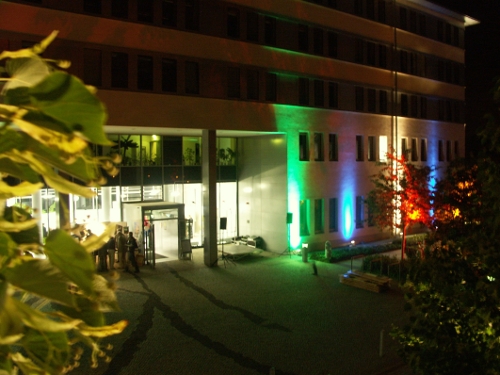Causes and Consequences of artificial night lighting for environment, nature and man – Loss of the night, effect of light pollution on birds
Project part BILL (Birds in ILluminated Landscapes)
Project management: Dr. Reinhard Klenke
Staff responsible: Dipl. Biol. Anja Nordt, Dipl.-Ing. (FH) Sarah Effertz
External Collaborations: Prof. Dr. Almuth Einspanier - Universität Leipzig, Dr. Jutta Gottschalk - Universität Leipzig, Dr. Susanne Reitemeier - Universität Leipzig, all partners of the project "Loss of the Night"
Funded by: German Federal Ministry of Education and Research
(Code: 033L038E)
Project duration: 01.05. 2010 - 30.04. 2013
Description
The spreading of human settlements into rural areas leads to a modified land use and increased landscape fragmentation. Furthermore, these previously not or only marginal affected areas now encounter new factors associated with civilization. Artificial light is one of them.

Beleuchtetes Gebäude (Foto: Doris Böhme / UFZ)
With light we positively associate safety, wealth and modernity, but its shady sides are poorly understood. While air, noise and water pollution reached public awareness and thus are focused by comprehensive research, on the concept of light pollution closer attention was drawn only recently.
Directed by the Leibniz-Institute of Freshwater Biology and Inland Fisheries (IGB)ecological, chronobiological as well as cultural and socioeconomic causes and consequences on man and environment of the "loss of the night" will be investigated by a multidisciplinary network of scientists. Based on their findings and conclusions, recommendations for politics and industry will be conveyed to use artificial light more efficiently. Our group investigates the influences of different light regimes on bird populations in the subproject BILL (Birds in ILluminated Landscapes).
Birds are characterized by an exceptional visual sense, they are even able to see ultraviolet radiation. Especially songbirds adjust their behavior to the rhythm of night and day, e.g. time their dawn song due to changing light intensities (bird clock). The increase in light pollution – around 6 % p.a. – pose a particular challenge for their ability to adapt. Investigating the effects of artificial night lighting on foraging, mate choice and breeding behavior, we will shed light on physiological costs and ecological consequences in the common blackbird (Turdus merula) in the urban area of Leipzig. Accompanying lighting experiments take place in a sample area in the Westhavelland.

Amsel (Turdus merula, Foto: Malene Thyssen)Publications
Publications
http://dx.doi.org/10.1111/jav.01210
http://dx.doi.org/10.1002/ece3.1820
http://dx.doi.org/10.3390/su71115593
http://www.aulis.de/newspaper_view/praxis-der-naturwissenschaften-biologie-in-der-schule.html?edition=lichtverschmutzung
http://dx.doi.org/10.1007/s10336-014-1105-1
http://www.wiley.com/WileyCDA/WileyTitle/productCd-3527411798.html
http://www.plosone.org/article/info%3Adoi%2F10.1371%2Fjournal.pone.0071476
http://www.philosophische-bauern.de/
http://www.ecologyandsociety.org/vol15/iss4/art13/
